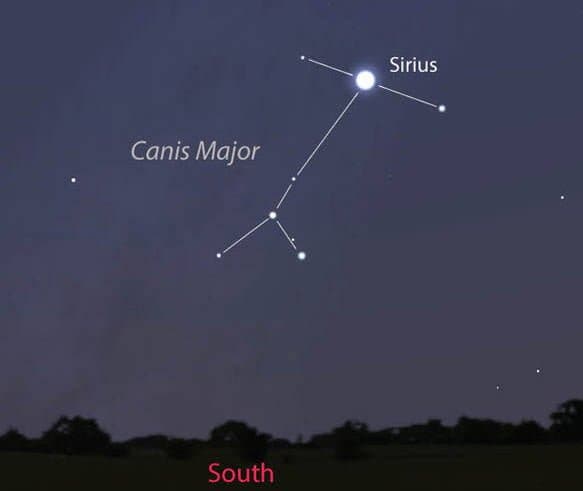
As you are aware, numerous parts of the celestial sphere have been discovered. Are you familiar with the most luminous constellation?
– Are you fond of the celestial sphere?
– Yes, I enjoy gazing at the stars. I just don’t know their names….
– Why do they require our designations?
Sergei Lukyanenko. Labyrinth of Reflections
Undoubtedly, these are the most exquisite formations in our cosmos. It is unimaginable how many enigmas each of them holds. Despite the fact that scientists have been examining them since ancient times. We have captured numerous breathtaking images of star clusters. Furthermore, we observe them while gazing at the night sky.
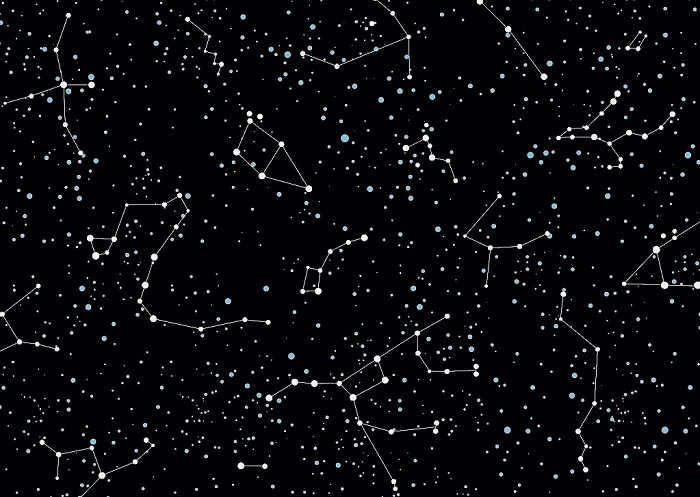
Most likely, everyone who gazes upon the stars has pondered at least once: which constellation shines the brightest in the night sky? Let’s attempt to find an answer.
As we are aware, the sky is traditionally divided into two sections: the Northern and Southern hemispheres. Consequently, one brilliant constellation is allocated to each hemisphere.
Orion
The most prominent constellation in the northern hemisphere is Orion. It is composed of stars that create the shape of a hunter.
Furthermore, there are numerous stunning and vibrant features within its domain. One such example is the breathtaking Great Orion Nebula, as well as Orion’s Trapezium and its Belt. Additionally, the constellation appears to be illuminated by the neighboring stars of Taurus and Canis Major, also known as the Dog.

The Most Brilliant Constellation in the Southern Hemisphere
In the southern hemisphere, the Southern Cross is the most radiant constellation. What is fascinating is that it occupies the smallest area compared to other prominent constellations. Indeed, the four luminous stars in the region form a cross-shaped pattern.
Although concealed within the expanse of the Cross is the dark Coal Sack Nebula. However, this does not diminish the brightness of its other constituents.
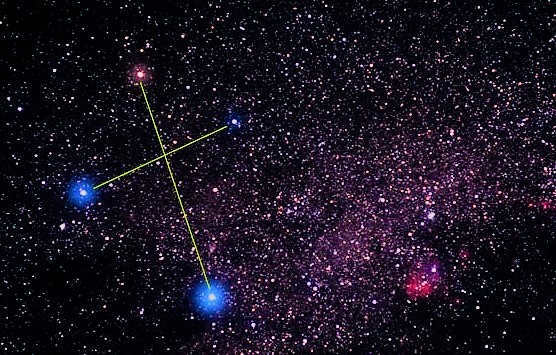
The Brightest Constellation: Centauri
When it comes to the most visible constellation from Earth, Centaurus takes the crown. It covers the largest area of the sky and is known for its rich collection of fascinating and stunning celestial objects.
When we gaze at the night sky, we only see a small fraction of the stars that make up constellations. However, these are the most breathtaking sights. Thanks to telescopes and satellites, we are able to marvel at the beauty of the cosmos. Undoubtedly, the brightest constellations captivate us with their brilliance.
The constellation Orion is renowned for its exquisite beauty in the nocturnal expanse. It holds a special place in the memories of many, as its celestial wonders captivate from an early age. Its prominent stars and celestial objects command attention, shining brilliantly in the night sky for all to see. Among these celestial luminaries are those that surpass even the Sun in their radiance, as well as the breathtaking M42 Large Nebula. The two bright stars, Rigel and Betelgeuse, serve as beacons in the constellation, facilitating its identification amidst the cosmic expanse.
Description
Orion is a legendary figure from ancient mythology, renowned for his impressive hunting skills and his close relationship with Artemis, the goddess of the hunt. According to ancient tales, Orion was brought to the celestial realm by Artemis herself, after he was tragically killed by his jealous brother Apollo. As a testament to their eternal bond, Artemis immortalized Orion by placing his image in the night sky as a majestic constellation.
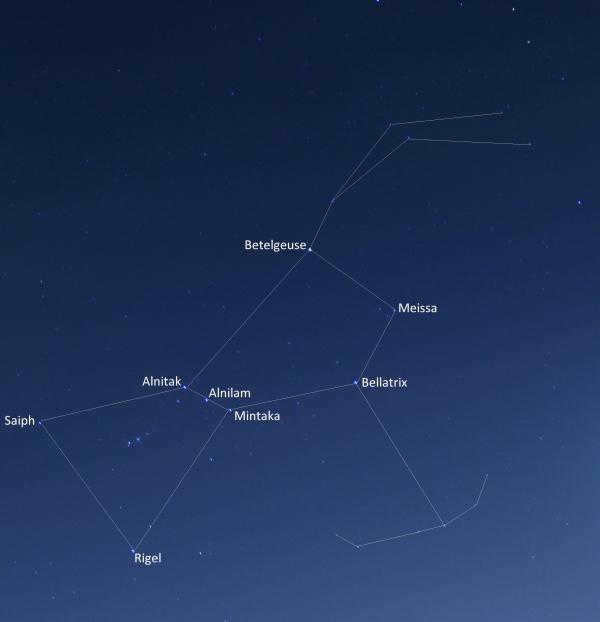
It is quite simple to identify the figure of the hunter in the arrangement of celestial bodies. He appears motionless in the sky, holding a raised club, a sword hanging from his belt, and a shield in his hand. The various components of the constellation represent well-known asterisms. The sheaf of stars forms a distinctive shape. Three highly noticeable stars in a straight line create Orion’s belt. Just below, there is the Sword of Orion asterism, which consists of two stars and a hazy cluster of the M42 nebula. The belt directs attention towards Sirius, located at the southeastern end of the line, and Aldebaran, found at the northwestern end.
Every star in the constellation of Orion is impressive. The surrounding constellations lack beauty due to the absence of such magnificent luminosities.
The epitome of superiority
Amidst this splendor, two giants stand out. The historical names of these bright stars in the Orion constellation are Rigel and Betelgeuse. Their scientific labels are Beta and Alpha Orion, respectively. Both giants are easily visible from Earth, competing for the title of the primary star in this celestial pattern. Betelgeuse holds the title of Alpha, but Rigel shines slightly brighter.
The constellation Orion contains two bright stars with names of Arabic origin. Rigel, which means “foot,” is located at the hunter’s leg, while Betelgeuse, meaning “armpit,” is positioned at the right armpit of Orion’s Alpha.
The red supergiant star
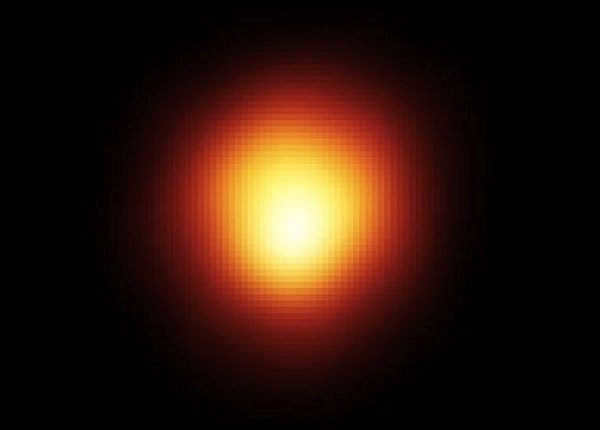

In many ways, Betelgeuse can be considered the most prominent star in the Orion constellation. It is classified as a red supergiant and belongs to the category of semi-regular variable stars, with its brightness ranging from 0.2 to 1.2 stellar magnitudes. Notably, the lower limit of its brightness exceeds that of the Sun by eighty thousand times. The estimated distance between Betelgeuse and Earth averages around 570 light years (the exact value remains unknown).
The magnitude of Betelgeuse can be comprehended by comparing it to the dimensions of the solar system’s planetary orbits. If the minimum size of the star were to replace our own celestial body, it would encompass the entirety of space up to the orbit of Mars. On the other hand, the maximum size would align with the orbit of Jupiter. Betelgeuse’s mass is 13 to 17 times more substantial than that of the Sun.
The Challenges of Studying Alpha Orion
Alpha Orion, also known as Betelgeuse, presents several challenges for researchers due to its immense size. With a volume that is 300 million times that of the Sun, accurately measuring its diameter is a complex task. The brightness of Betelgeuse gradually decreases as it moves away from its center, making it difficult to determine its exact dimensions. Current estimates suggest that if the distance to Betelgeuse is considered to be 650 light years, its diameter could range between 500 and 800 times that of our own star.
Betelgeuse – the inaugural celestial body beyond the Sun, for which the space telescope managed to procure an image of the disk. The image apprehended the ultraviolet atmosphere of the luminary with a radiant spot in the midst. Its dimensions surpass several tens of Earth’s diameters. The temperature in this region is significantly higher than on the remaining expanse of the cosmic entity. The genesis of the spot remains enigmatic. It is conjectured that it embodies the outcome of the atmosphere of the star being affected by a novel physical phenomenon.
Orion’s limb
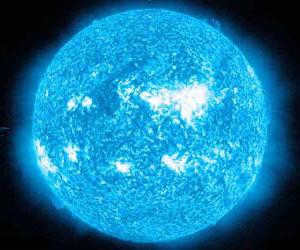

Rigel is known as the most brilliant star in the Orion constellation. People often use the neighboring constellations, Hare and Eridanus, to locate Rigel in the night sky. It serves as a helpful reference point for observers due to its brightness.
Rigel is classified as a blue-white supergiant with a visual magnitude of 0.12. It is located approximately 860 light-years away from the Sun. Rigel has a smaller radius compared to Betelgeuse, another star in Orion. However, Rigel’s luminosity is 130 thousand times greater than that of our Sun, surpassing even Alpha Orion in this aspect.
Rigel, similar to Betelgeuse, is a star that displays variability in its brightness. Its magnitude fluctuates irregularly, ranging from 0.3 to 0.03 over a period of approximately 24 days. In astronomical terms, Rigel is commonly referred to as a triple star system, but there are also claims that it may have a fourth component. However, there is currently no definitive proof to support the existence of this fourth component.
Neighbour
The Witch’s Head nebula is connected with Beta Orionis. It bears a striking resemblance to a witch’s head wearing a pointed hat. This nebula is reflective and shines because of its close proximity to Rigel. In photographs, the Witch’s Head appears blue, as the cosmic dust particles that make up the nebula reflect blue light more effectively, and Rigel emits primarily in the blue part of the light spectrum.
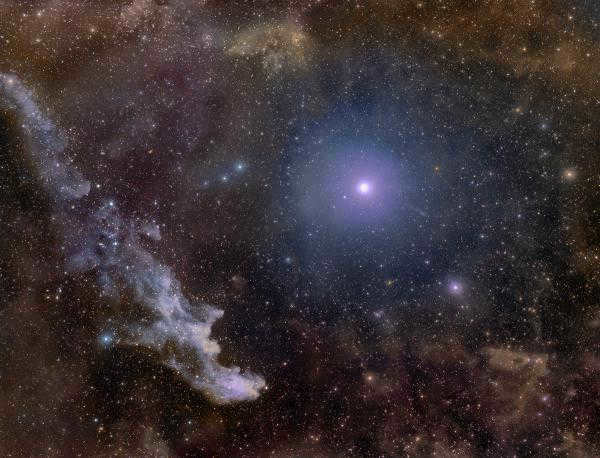
The Process of Evolution
The two prominent stars within the Orion constellation will not remain as they are forever. The internal mechanisms of both stars will eventually deplete their fuel and potentially lead to an explosion. Their impressive size does not lend itself to long-term existence. However, for the present time, they will certainly endure. Betelgeuse is predicted to radiate its brilliance for at least another two millennia. Afterward, it will collapse and erupt. Simultaneously, its luminosity will rival that of the half or even the full Moon. Alternatively, Betelgeuse may “silently” transform into a white dwarf. In any case, from the perspective of an Earth observer, the radiance of Orion’s shoulder will eventually fade away.
Rigel is also anticipating its moment to illuminate the heavens for a brief period with a massive explosion of energy. Based on predictions, its intensity will be on par with a quarter of the Moon.
Additional celestial bodies
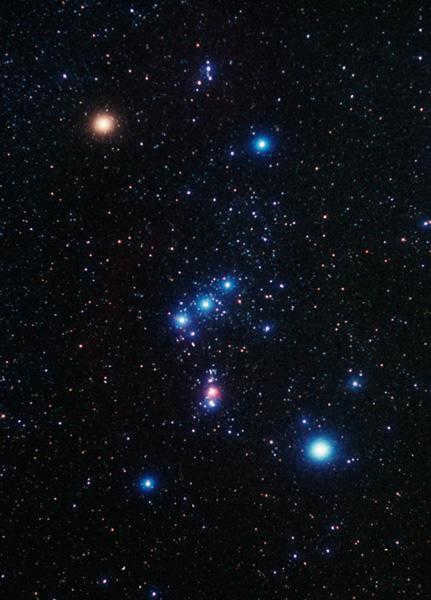
Not only are the two prominent stars in the Orion constellation highly visible, but there are also other notable objects in this celestial pattern. The belt of the hunter consists of three luminaries that can be clearly seen from Earth. These include Mintaka (Orion’s Delta), Alnitak (Zeta), and Alnilam (Epsilon). On the left shoulder of the hunter is Bellatrix (Orion’s Gamma), which is the third brightest point in the constellation. It shines with a luminosity that is 4,000 times greater than that of the Sun. Among the stars that can be observed with the naked eye, Bellatrix stands out due to its significant surface heating. Its temperature is estimated to be 21,500 degrees Kelvin.
Nebulae and black holes
There are two additional prominent celestial objects in the Orion constellation that can be found just below the Belt and are part of the Sword of the Hunter. These objects are known as Theta and Iota of Orion. Positioned between them is a third entity that, due to lack of knowledge, might mistakenly be classified as a star. However, this is actually the Great Orion Nebula, which appears as a small, indistinct spot from our perspective on Earth. This nebula serves as a birthing ground for new stars and is believed to also harbor the nearest black hole to Earth, which boasts a mass 100 times that of the Sun.
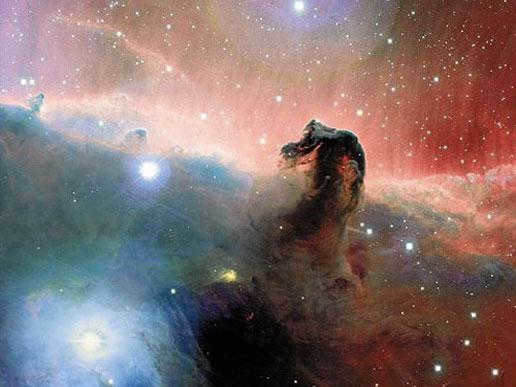
Equally well-known as M42 are the Torch and Horsehead nebulae, which can also be found in the Orion constellation. The Torch nebula resembles flames flickering above a bonfire, hence its name. Similarly, the Horsehead Nebula derives its name from its distinct shape, resembling the silhouette of a horse. It appears as if the horse is on the verge of galloping away. The Horsehead Nebula is a reflection nebula, meaning it does not emit light on its own. The illumination comes from the background nebula IC 434, allowing us to appreciate its presence.
The constellation of Orion is frequently depicted in numerous telescope images. The captivating beauty of stars, nebulae, gas clouds, and cosmic dust never ceases to amaze in these photographs. Nevertheless, the silhouette of the hunter appears equally impressive when observed from Earth. The abundance of bright and easily observable objects with the naked eye in this constellation is perhaps unmatched by any other celestial images.
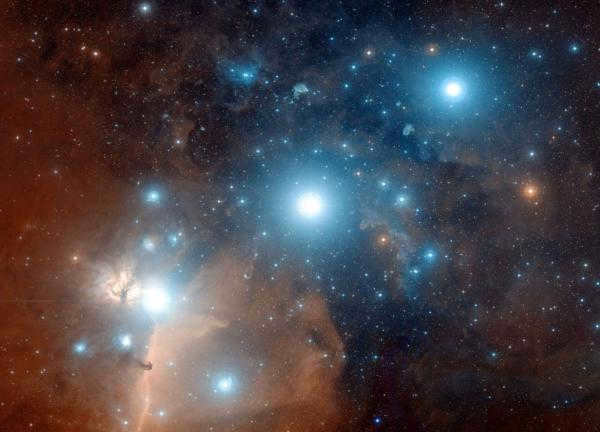
For those who desire to behold all the wonders concealed by the legendary hunter, there exist various astronomical tools accessible for delving into the constellation Orion, along with other celestial formations: Astrogalactica, the Google Sky star map, and the Google Earth service.

At present, 58,744 educational institutions have the opportunity to benefit from additional cumulative discounts ranging from 2% to 25%. To determine the discount that is applicable to all staff members of your educational institution, please access your personal Infoworks account.


Professional development course
Development of meta-subject competencies of students during lessons in Fine Arts and Art.
We can include the discount of your educational institution along with this offer (it depends on how many of your colleagues have already enrolled in Infowork courses).
Currently, there are additional cumulative discounts available (ranging from 2% to 25%) for 58,744 educational institutions. To determine the applicable discount for all staff members of your educational institution, please log in to your personal Infoworks account.




Course for professional development
Typhlopedagogics: organizing education, upbringing, correcting developmental disorders, and socially adapting blind and visually impaired students in the implementation of the FSES program.
In addition to this offer, we can include the discount provided by your educational institution (based on how many of your colleagues have taken Infowork courses).
Currently, 58,744 educational institutions are eligible for additional discounts (ranging from 2% to 25%). To find out the discount available for all employees of your educational institution, please log in to your personal Infoworks account.




Developing reading skills in students during classroom lessons
Overview of the presentation using individual slides:

2 slide Ptolemy Claudius Claudius (c. 90 – c. 160),
an ancient Greek scientist,
was the final prominent astronomer of the ancient world.
He created specialized astronomical
devices including the astrolabe, the armillary sphere,
and the triquetrum. He documented the positions of 1022 stars.
Ptolemy’s comprehensive system is outlined in his most significant work,
“Almagest”.
“The Great Mathematical Construction of Astronomy in XIII Books” –
an encyclopedia of ancient astronomical knowledge.
In ancient times, astronomers divided the night sky into constellations.
Many of the constellations named by Hipparchus and Ptolemy were given names of animals or mythological heroes.
Hipparchus, who lived around 180 or 190 – 125 BC, was an influential astronomer in ancient Greece and played a crucial role in the development of astronomy. He is considered one of the founding figures of this scientific field. Among his notable achievements, Hipparchus compiled an extensive star catalog consisting of 850 stars. To measure their brightness, he introduced a scale known as stellar magnitudes. Additionally, he organized the stars into 28 constellations.

On slide 3, Claudius Ptolemy, an ancient Greek astronomer, discusses 48 constellations in his Almagest ("The Great Mathematical Construction of Astronomy in XIII Books", 2nd century AD). These constellations include the Big Dipper and Little Dipper, the Dragon, the Swan, the Eagle, Taurus, Libra, and many more.

Slide 4: The most remarkable constellations in numerous countries have been given their names. For example, the ancient Slavs represented the Big Dipper as an Elk or a Deer. The bucket of the Big Dipper was often compared to a wagon, which is why this constellation has names like Voz, Cart, and Chariot.
In the III century BC, ancient Greek astronomers unified the names of constellations into a single system associated with Greek mythology.
For instance, the constellation Cassiopeia, which was named after the legendary queen, was depicted to the people of Belarus as two farmers mowing the grass. Contemporary astronomical charts no longer feature illustrations of mythical constellation figures, but their ancient names remain intact.
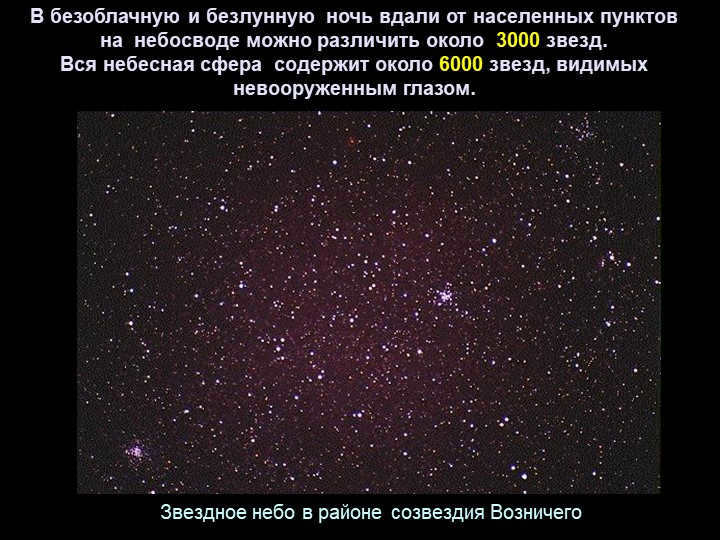
On a clear and moonless night, away from areas with high population density, one can observe the sky.
Approximately 3000 stars can be distinguished in the sky in such conditions.
There are about 6000 stars visible to the naked eye in the entire celestial sphere.
The starlit sky can be observed in the region where the Ascendant constellation is located.
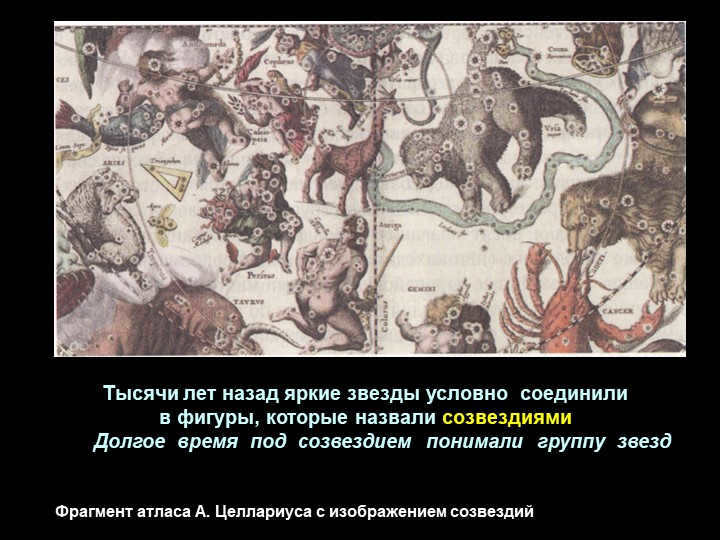
6 slide In ancient times, the luminous stars were traditionally organized into formations known as constellations. These constellations were long regarded as groups of stars.
Fragment of A. Cellarius’ atlas featuring depictions of constellations.
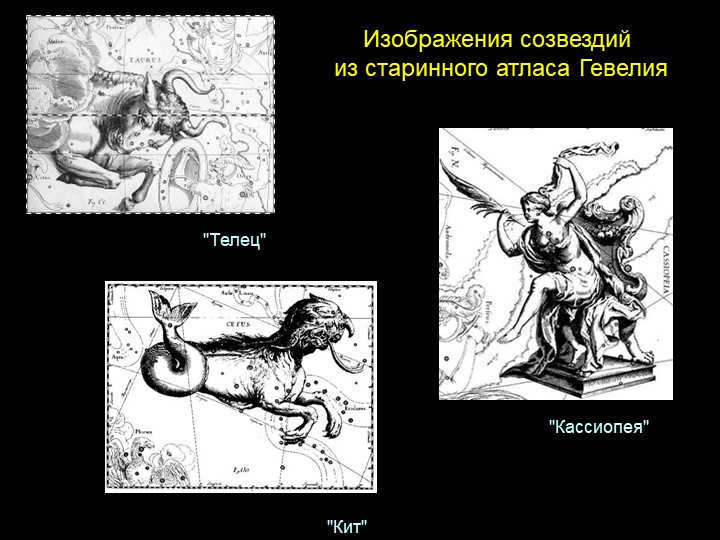
Currently, a constellation is commonly defined as a specific region of the celestial sphere,
with its boundaries established by the International Astronomical Union (IAU).
There are a total of 88 constellations present on the celestial sphere.
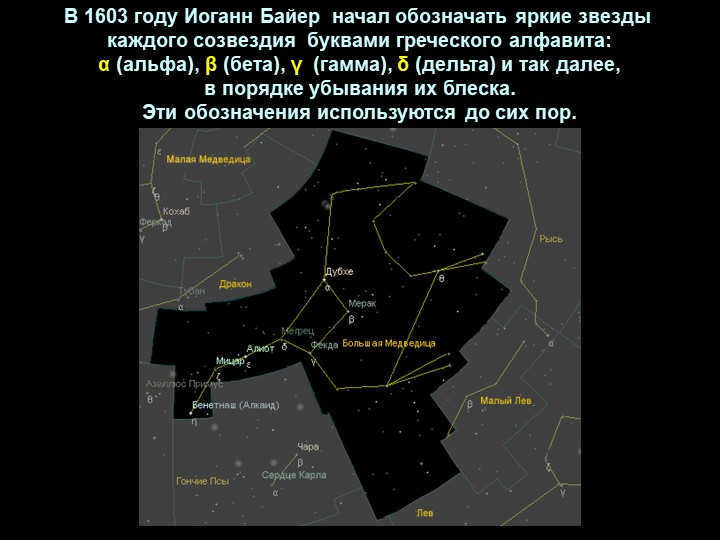

Slide 9 In 1603, Johann Bayer initiated the practice of assigning Greek alphabet letters to the most luminous stars within each constellation, starting with alpha (α), beta (β), gamma (γ), delta (δ), and so on, in order of decreasing brightness. These designations continue to be used to this day.

During the 2nd century BC, Hipparchus, an influential figure in the field of astronomy, implemented a traditional system for measuring the brightness of stars. The most luminous stars were designated as being of the 1st magnitude, followed by stars of the 2nd magnitude which were approximately 2.5 times fainter. The faintest stars, only visible on moonless nights, were classified as stars of the 6th magnitude.
Within the night sky, there are only a total of 12 stars that are classified as being of the 1st magnitude.
Ancient Greek and Arab astronomers came up with names for many bright stars, such as Vega, Sirius, Capella, Altair, Rigel, Aldebaran, and others. Later on, the practice of designating bright stars in constellations using letters of the Greek alphabet became popular, usually in order of decreasing brilliance.
Since 1603, the star designation system proposed by German astronomer Johann Bayer has been used. In Bayer’s system, a star’s name consists of two parts: the name of the constellation it belongs to and a letter of the Greek alphabet. In this system, the brightest star in the constellation is assigned the first letter of the Greek alphabet, α, the second brightest star is assigned β, and so on.


Slide 11: The Sun’s visible path throughout the year passes through thirteen constellations, commencing at the vernal equinox:
Aries, Taurus, Gemini, Cancer, Leo, Virgo, Libra, Scorpio, Serpentor, Sagittarius, Capricorn, Aquarius, and Pisces.
According to ancient tradition, only twelve of these constellations are considered zodiacal.
The constellation of Serpentor is not included in the zodiacal constellations.

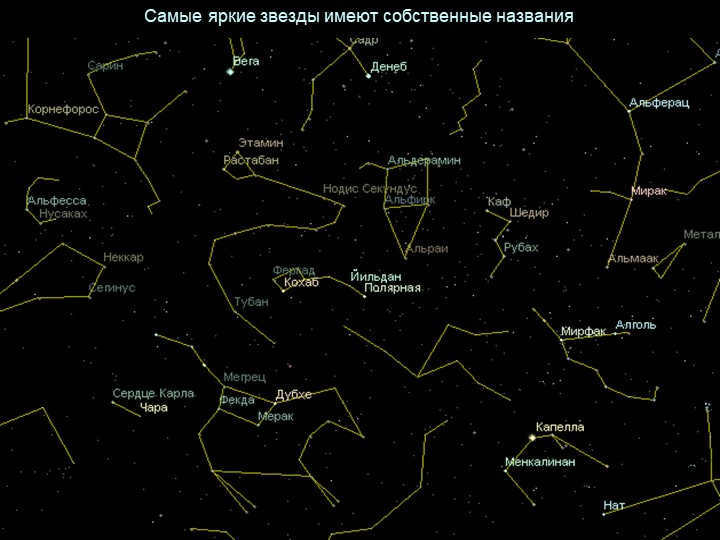

Only 58 constellations have the designation α (alpha) for their brightest stars.
There are 13 constellations where the brightest stars are designated as β (beta),
and in other constellations, different letters of the Greek alphabet are used.
The constellation Hydra is the largest in terms of size, covering
an area of 1303 square degrees.
The smallest constellation in terms of size is the Southern Cross,
which covers an area of 68 square degrees.
The largest constellation visible in the northern hemisphere is the Big Dipper,
which covers an area of 1280 square degrees.
The constellation Orion has the largest number of stars brighter than second magnitude,
with a total of 5 stars.
The constellation Big Dipper has the largest number of stars brighter than fourth magnitude,
with a total of 19 stars.
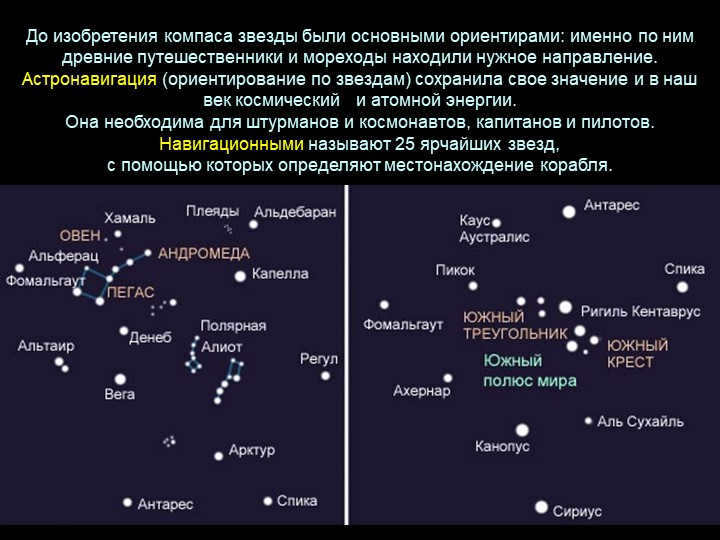
Before the compass was invented, the stars served as the primary means of navigation: they were the foundation for early explorers and seafarers to find the correct course.
Today, celestial navigation (navigating by the stars) still holds significance in our era of space exploration and atomic power.
It is essential for navigators and astronauts, as well as ship captains and pilots.
The 25 brightest stars are referred to as navigational stars,
which are utilized to determine a ship’s position.
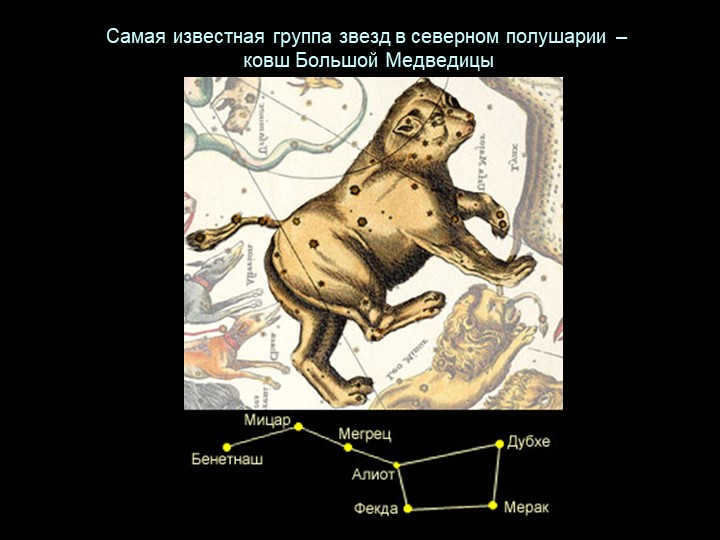
Slide 18: The Big Dipper constellation can be a helpful tool for memorizing the most prominent stars in the Northern Hemisphere. It is simple to identify the direction north by using the handle of the Big Dipper.
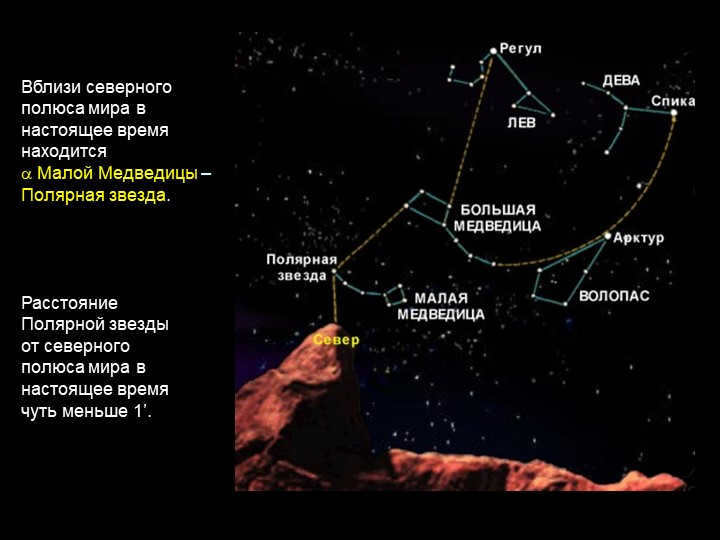

Slide 19: At present, Polaris is situated just under 1 minute away from the north pole of the world.
Currently, near the north pole of the world, you can find the brightest star in the Little Bear constellation – Polaris.
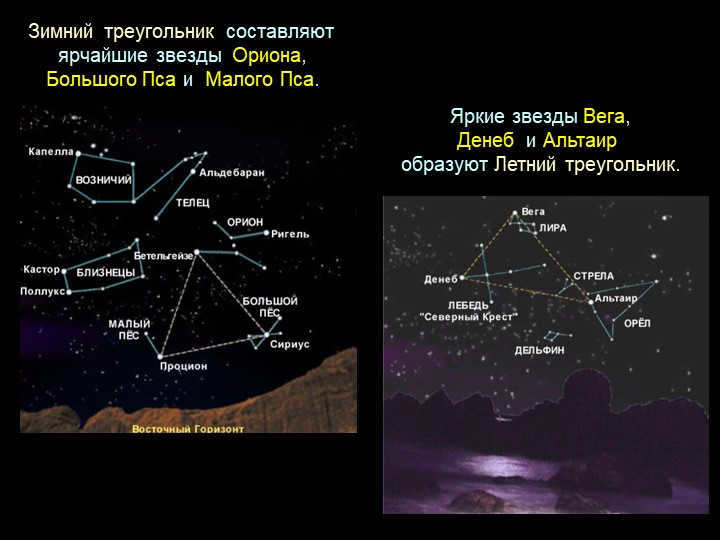

The Winter Triangle consists of the most luminous stars in Orion, the Big Dog, and the Little Dog.
The Summer Triangle is formed by the bright stars Vega, Deneb, and Altair.
- Evidence for your portfolio
- Unlimited access for just 99 rubles
- Over 3,800 video lectures for everyone

The Brightest Constellation. The constellation Orion is frequently depicted on ancient monuments. So, what made it so significant to ancient civilizations? Numerous ancient civilizations revered the gods whose home was believed to be in the constellation Orion. In order to honor these gods, they constructed monuments that replicated this particular region of the night sky…..
A truly unique Orion constellation.
Humanity has been aware of this constellation for centuries. It has captivated the imagination of people since ancient times, predating the science of astronomy. Why? Perhaps because within the Orion constellation lies a nebula, a celestial nursery where stars are born. It is highly unlikely that our ancestors possessed this knowledge.
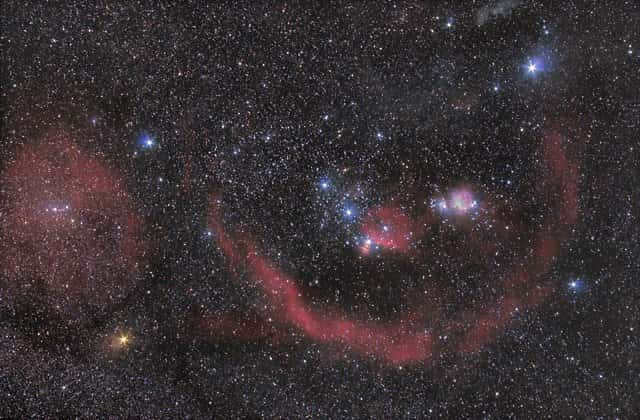
Orion is an incredibly bright constellation and is widely recognized by both amateur and professional stargazers. It is named after the Greek demigod Orion, who was known for his exceptional hunting skills and imposing stature. According to ancient Greek mythology, Zeus honored Orion’s accomplishments by placing him among the stars after his death…
The constellation’s iconic belt is formed by the stars Alnilam, Alnitak, and Mintaka, which are the main attractions within Orion.
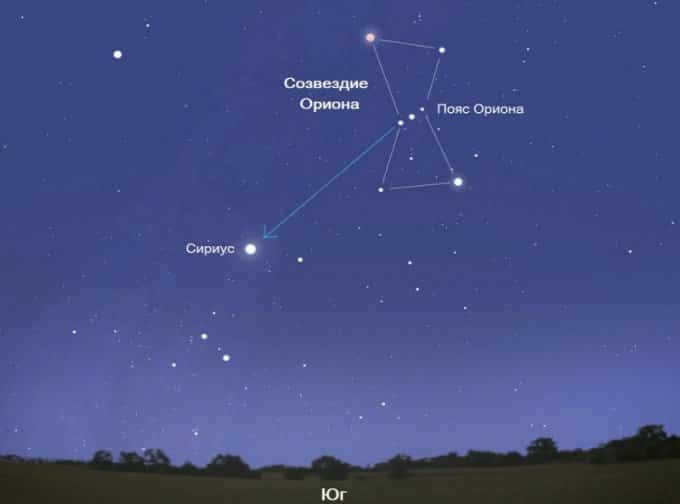
According to historical accounts, there are various myths and legends surrounding the birth and death of the constellation Orion. These legends vary in their details, but all provide intriguing insights…
Visitors from the Celestial Realm
According to Egyptian mythology, the gods descended upon Earth from the distant stars. These stars were none other than the ones forming Orion’s belt and Sirius. The ancient Egyptians held the belief that humanoid beings originated from these celestial bodies. They referred to these extraterrestrial entities as Osiris and Isis. According to ancient Egyptian texts, it was these beings who played a pivotal role in the creation of our civilization.
Sirius and the Orion constellation held significant importance not only for the Greeks and Egyptians but also for various other ancient civilizations such as Babylonia and the Indian empires of South and Central America. Even the indigenous tribes of North America, like the Native Americans, revered these celestial entities.
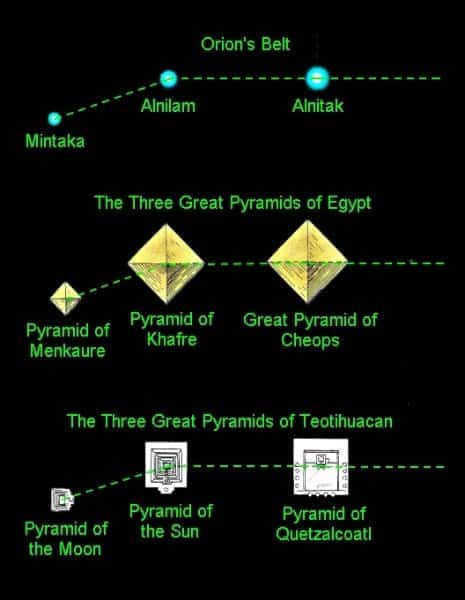
Is it a mere coincidence that some of the renowned ancient structures on our planet are positioned in a way that mimics the alignment of stars in the Orion belt? Do these structures, constructed by civilizations that have no connection, signify that the Orion belt held a significance beyond being mere luminous dots in the sky for our ancestors? Or is it simply a remarkable, random happenstance? Why did the Aztecs, Mayans, ancient Egyptians, and other ancient cultures choose to single out these specific stars among the countless others in the night sky?
He has departed. And made no pledge to return
Another piece of information. Within one of the pyramids in Egypt, there have been discoveries of writings from around 2400 B.C. These writings chronicle the life of the Egyptian pharaoh Unis, who governed for over three decades. According to these texts, Unis did not pass away at the end of his rule, as was customary for Egyptian pharaohs. Instead, he ascended into the sky. Towards one of the stars within the constellation Orion.
A fascinating aspect is that the Babylonians depict the constellation Orion as both a celestial formation and a divine entity. It is referred to in ancient writings as the “Loyal Guardian of the Heavens.”

